Ginkgo biloba L. Responds to Red and Blue Light: Via Phenylpropanoid and Flavonoid Biosynthesis Pathway
Abstract
:1. Introduction
2. Materials and Methods
2.1. Plant Materials and Treatments
2.2. Determination of Seeding Height, Diameter and Biomass
2.3. RNA Extraction, Library Construction, and Transcriptome Sequencing
2.4. Sequencing Quality Evaluation and Sequence Alignment
2.5. Screening, Functional Annotation, and Enrichment Analysis of Differentially Expressed Genes (DEGs)
2.6. Quantitative Real-Time PCR (qRT-PCR) Validation of Differential Expression
3. Results
3.1. Difference Analysis of Growth Indexes of G. biloba under Different Monochromatic Light
3.2. Transcriptome Sequencing Statistics and Quality Assessment
3.3. Functional Annotation of Unigenes
3.4. Analysis of DEGs under Different Monochromatic Lights
3.5. Analysis of GO Annotations of DEGs
3.6. KEGG Enrichment Analysis of DEGs
3.7. Analysis of DEGs Related to the Phenylpropanoid Biosynthesis Pathway
3.8. Analysis of DEGs Related to the Flavonoid Biosynthesis Pathway
3.9. Validation of RNA-Seq Based DEGs Results by qRT-PCR
4. Discussion
4.1. Functional Annotation Analysis of DEGs
4.2. Analysis of Phenylpropanoid Biosynthesis Pathway in G. biloba under Different Monochromatic Lights
4.3. Analysis of the Flavonoid Biosynthesis Pathway in G. biloba under Different Monochromatic Lights
5. Conclusions
Supplementary Materials
Author Contributions
Funding
Acknowledgments
Conflicts of Interest
References
- Bian, Z.H.; Yang, Q.C.; Liu, W.K. Effects of light quality on the accumulation of phytochemicals in vegetables produced in controlled environments: A review. J. Sci. Food Agr. 2015, 95, 869–877. [Google Scholar] [CrossRef]
- Roso, R.; Nunes, U.R.; Müller, C.A.; Paranhos, J.T.; Lopes, S.J.; Dornelles, S.H.B.; Bertagnolli, C.M.; Huth, C.; Forte, C.T.; Menegaes, J.F. Light quality and dormancy overcoming in seed germination of Echium plantagineum L. (Boraginaceae). Braz. J. Biol. 2021, 81, 650–656. [Google Scholar] [CrossRef] [PubMed]
- Li, Y.; Liu, C.; Shi, Q.; Yang, F.; Wei, M. Mixed red and blue light promotes ripening and improves quality of tomato fruit by influencing melatonin content. Environ. Exp. Bot. 2021, 185, 104407. [Google Scholar] [CrossRef]
- Massa, G.D.; Kim, H.; Wheeler, R.M.; Mitchell, C.A. Plant Productivity in Response to LED Lighting. Hortscience 2008, 43, 1951–1956. [Google Scholar] [CrossRef]
- Ahmad, M.; Lin, C.; Cashmore, A.R. Mutations throughout an Arabidopsis blue-light photoreceptor impair blue-light-responsive anthocyanin accumulation and inhibition of hypocotyl elongation. Plant J. Cell Mol. Biol. 1995, 8, 653–658. [Google Scholar] [CrossRef] [PubMed]
- Möglich, A.; Yang, X.; Ayers, R.A.; Moffat, K. Structure and function of plant photoreceptors. Annu. Rev. Plant Biol. 2010, 61, 21–47. [Google Scholar] [CrossRef] [PubMed] [Green Version]
- Franklin, K.A.; Quail, P.H. Phytochrome functions in Arabidopsis development. J. Exp. Bot. 2010, 61, 11–24. [Google Scholar] [CrossRef] [Green Version]
- Rockwell, N.C.; Su, Y.; Lagarias, J.C. Phytochrome structure and signaling mechanisms. Annu. Rev. Plant Biol. 2006, 57, 837–858. [Google Scholar] [CrossRef] [PubMed] [Green Version]
- Yang, Z.; Kubota, C.; Chia, P.; Kacira, M. Effect of end-of-day far-red light from a movable LED fixture on squash rootstock hypocotyl elongation. Sci. Hortic. 2012, 136, 81–86. [Google Scholar] [CrossRef]
- Li, Q.; Xu, J.; Yang, L.; Sun, Y.; Zhou, X.; Zheng, Y.; Zhang, Y.; Cai, Y. LED Light Quality Affect Growth, Alkaloids Contents, and Expressions of Amaryllidaceae Alkaloids Biosynthetic Pathway Genes in Lycoris longituba. J. Plant Growth Regul. 2021. [Google Scholar] [CrossRef]
- Li, Y.; Xin, G.; Wei, M.; Shi, Q.; Yang, F.; Wang, X. Carbohydrate accumulation and sucrose metabolism responses in tomato seedling leaves when subjected to different light qualities. Sci. Hortic. 2017, 225, 490–497. [Google Scholar] [CrossRef]
- Liu, H.; Chen, Y.; Hu, T.; Zhang, S.; Zhang, Y.; Zhao, T.; Yu, H.; Kang, Y. The influence of light-emitting diodes on the phenolic compounds and antioxidant activities in pea sprouts. J. Funct Foods 2016, 25, 459–465. [Google Scholar] [CrossRef]
- Pooam, M.; Dixon, N.; Hilvert, M.; Misko, P.; Waters, K.; Jourdan, N.; Drahy, S.; Mills, S.; Engle, D.; Link, J. Effect of temperature on the Arabidopsis cryptochrome photocycle. Physiol. Plantarum. 2021, 172, 1653–1661. [Google Scholar] [CrossRef]
- Wang, Q.; Lin, C. Mechanisms of cryptochrome-mediated photoresponses in plants. Annu. Rev. Plant Biol. 2020, 71, 103–129. [Google Scholar] [CrossRef] [Green Version]
- Morrow, R.C. LED Lighting in Horticulture. Hortscience 2008, 43, 1947–1950. [Google Scholar] [CrossRef] [Green Version]
- Togawa, T.; Fujita, T.; Dong, L.; Fujii, M.; Ooba, M. Feasibility assessment of the use of power plant-sourced waste heat for plant factory heating considering spatial configuration. J. Clean Prod. 2014, 81, 60–69. [Google Scholar] [CrossRef]
- Kim, H.R.; You, Y.H. Effects of Red, Blue, White, and Far-red LED Source on Growth Responses of Wasabia japonica Seedlings in Plant Factory. Hortic. Sci. Technol. 2013, 31, 415–422. [Google Scholar]
- Fanwoua, J.; Vercambre, G.; Buck-Sorlin, G.; Dieleman, J.A.; de Visser, P.; Génard, M. Supplemental LED lighting affects the dynamics of tomato fruit growth and composition. Sci. Hortic. 2019, 256, 108571. [Google Scholar] [CrossRef]
- Jishi, T.; Kimura, K.; Matsuda, R.; Fujiwara, K. Effects of temporally shifted irradiation of blue and red LED light on cos lettuce growth and morphology. Sci. Hortic. 2016, 198, 227–232. [Google Scholar] [CrossRef]
- Choi, H.G.; Moon, B.Y.; Kang, N.J. Effects of LED light on the production of strawberry during cultivation in a plastic greenhouse and in a growth chamber. Sci. Hortic. 2015, 189, 22–31. [Google Scholar] [CrossRef]
- Hernandez, R.; Kubota, C. Physiological, Morphological, and Energy-use Efficiency Comparisons of LED and HPS Supplemental Lighting for Cucumber Transplant Production. Hortscience 2015, 50, 351–357. [Google Scholar] [CrossRef]
- Li, C.X.; Chang, S.X.; Khalil Ur Rehman, M.; Xu, Z.G.; Tao, J.M. Effect of irradiating the leaf abaxial surface with supplemental light-emitting diode lights on grape photosynthesis. Aust. J. Grape Wine Res. 2017, 23, 58–65. [Google Scholar] [CrossRef] [Green Version]
- Hu, W.H.; Wang, H.Y.; Xia, Y.T.; Dai, D.K.; Xiong, Q.P.; Dong, T.T.X.; Duan, R.; Chan, G.K.L.; Qin, Q.W.; Tsim, K.W.K. Kaempferol, a major flavonoid in Ginkgo folium, potentiates angiogenic functions in cultured endothelial cells by binding to vascular endothelial growth factor. Front. Pharmacol. 2020, 11, 526. [Google Scholar] [CrossRef]
- Shu, Z.; Shar, A.H.; Shahen, M.; Wang, H.; Alagawany, M.; Abd El-Hack, M.E.; Kalhoro, S.A.; Rashid, M.; Shar, P.A. Pharmacological uses of Ginkgo biloba extracts for cardiovascular disease and coronary heart diseases. Int. J. Pharmacol. 2019, 15, 1–9. [Google Scholar] [CrossRef]
- Mohanta, T.K.; Tamboli, Y.; Zubaidha, P.K. Phytochemical and medicinal importance of Ginkgo biloba L. Nat. Prod. Res. 2014, 28, 746–752. [Google Scholar] [CrossRef] [PubMed]
- Sharma, G.; Sharma, N.; Nguyen, B.T.; Jeong, J.H.; Nah, S.; Yoneda, Y.; Shin, E.; Kim, H. Protective potential of Ginkgo biloba against an ADHD-like condition. Curr. Mol. Pharmacol. 2021, 14, 200–209. [Google Scholar] [CrossRef]
- Wang, H.; Zhang, Y. The main active constituents and detoxification process of Ginkgo biloba seeds and their potential use in functional health foods. J. Food Compos. Anal. 2019, 83, 103247. [Google Scholar] [CrossRef]
- Zhou, M.; Hua, T.; Ma, X.; Sun, H.; Xu, L. Protein content and amino acids profile in 10 cultivars of ginkgo (Ginkgo biloba L.) nut from China. R. Soc. Open Sci. 2019, 6, 181571. [Google Scholar] [CrossRef] [Green Version]
- Li, W.; He, Z.; Yang, S.; Ye, Y.; Jiang, H.; Wang, L. Construction and analysis of a library of miRNA in gold-coloured mutant leaves of Ginkgo biloba L. Folia Hortic. 2019, 31, 81–92. [Google Scholar] [CrossRef] [Green Version]
- Wang, L.; Xing, S.Y.; Yang, K.Q.; Wang, Z.H.; Guo, Y.Y.; Shu, H.R. Genetic relationships of ornamental cultivars of Ginkgo biloba analyzed by AFLP techniques. Acta Genet. Sin. 2006, 33, 1020–1026. [Google Scholar] [CrossRef]
- Purusatama, B.D.; Kim, N.H. Cross-field pitting characteristics of compression, lateral, and opposite wood in the stem wood of Ginkgo biloba and Pinus densiflora. IAWA J. 2020, 41, 48–60. [Google Scholar] [CrossRef]
- Gao, X.; Jiao, Q.; Zhou, B.; Liu, Q.; Zhang, D. Diverse Bioactive Components from Ginkgo Biloba Fruit. Therm. Sci. 2020, 24, 1753–1760. [Google Scholar] [CrossRef]
- Zhu, J.; Cui, W.; Xiao, W.; Ding, Y.; Huang, W.; Tu, P.; Wang, Y. Isolation and enrichment of Ginkgo biloba extract by a continuous chromatography system. J. Sep. Sci. 2018, 41, 2432–2440. [Google Scholar] [CrossRef]
- Zhang, H.; Luo, Y.; Cao, Z.; Zhang, X.; Cao, L.; Wang, Z.; Xiao, W. Effect of compatibility of ginkgolide A, ginkgolide B and ginkgolide K. China J. Chin. Mater. Med. 2018, 43, 1410–1415. [Google Scholar]
- van Beek, T.A. Chemical analysis of Ginkgo biloba leaves and extracts. J. Chromatogr. A 2002, 967, 21–55. [Google Scholar] [CrossRef]
- Ye, J.; Ye, C.; Huang, Y.; Zhang, N.; Zhang, X.; Xiao, M. Ginkgo biloba sarcotesta polysaccharide inhibits inflammatory responses through suppressing both NF-κB and MAPK signaling pathway. J. Sci. Food Agr. 2019, 99, 2329–2339. [Google Scholar] [CrossRef]
- Leigh, A.; Zwieniecki, M.A.; Rockwell, F.E.; Boyce, C.K.; Nicotra, A.B.; Holbrook, N.M. Structural and hydraulic correlates of heterophylly in Ginkgo biloba. New Phytol. 2011, 189, 459–470. [Google Scholar] [CrossRef] [PubMed]
- Rudall, P.J.; Rowland, A.; Bateman, R.M. Ultrastructure of Stomatal Development in Ginkgo Biloba. Int. J. Plant Sci. 2012, 173, 849–860. [Google Scholar] [CrossRef]
- Zhang, W.; Xu, F.; Cheng, H.; Li, L.; Cao, F.; Cheng, S. Effect of Chlorocholine Chloride on Chlorophyll, Photosynthesis, Soluble Sugar and Flavonoids of Ginkgo biloba. Not. Bot. Horti. Agrobo. 2013, 41, 97–103. [Google Scholar] [CrossRef] [Green Version]
- He, J.; Lin, J.; Li, J.; Zhang, J.; Sun, X.; Zeng, C. Dual Effects of Ginkgo biloba Leaf Extract on Human Red Blood Cells. Basic Clin. Pharmacol. 2009, 104, 138–144. [Google Scholar] [CrossRef]
- Wei-ling, H.Y.M.Y. Extract of Ginkgo biloba promotes neuronal regeneration in the hippocampus after exposure to acrylamide. Neural Regen Res. 2017, 12, 1287–1293. [Google Scholar]
- Li, W.; Fitzloff, J.F. HPLC Determination of Flavonoids and terpene lactones in Commercial Ginkgo Biloba Products. J. Liq. Chromatogr. Relat. Technol. 2002, 25, 2501–2514. [Google Scholar] [CrossRef]
- Pereira, E.; Barros, L.; Duenas, M.; Antonio, A.L.; Santos-Buelga, C.; Ferreira, I.C.F.R. Gamma irradiation improves the extractability of phenolic compounds in Ginkgo biloba L. Ind. Crop. Prod. 2015, 74, 144–149. [Google Scholar] [CrossRef] [Green Version]
- Zhang, C.; Wang, C.; Tao, R. Analysis on the Physicochemical Properties of Ginkgo biloba Leaves after Enzymolysis Based Ultrasound Extraction and Soxhlet Extraction. Molecules 2016, 21, 97. [Google Scholar] [CrossRef] [Green Version]
- Guo, Y.; Wang, T.; Fu, F.; El-Kassaby, Y.A.; Wang, G. Metabolome and Transcriptome Analyses Reveal the Regulatory Mechanisms of Photosynthesis in Developing Ginkgo biloba Leaves. Int. J. Mol. Sci. 2021, 22, 2601. [Google Scholar] [CrossRef]
- Ni, J.; Dong, L.; Jiang, Z.; Yang, X.; Chen, Z.; Wu, Y.; Xu, M.; Min, X.J. Comprehensive transcriptome analysis and flavonoid profiling of Ginkgo leaves reveals flavonoid content alterations in day-night cycles. PLoS ONE 2018, 13, e193897. [Google Scholar] [CrossRef] [Green Version]
- Sun, S.; Li, Y.; Chu, L.; Kuang, X.; Song, J.; Sun, C. Full-length sequencing of ginkgo transcriptomes for an in-depth understanding of flavonoid and terpenoid trilactone biosynthesis. Gene 2020, 758, 144961. [Google Scholar] [CrossRef]
- Leng, P.S.; Su, S.C.; Wang, T.H.; Jiang, X.N.; Wang, S.S. Effects of light intensity and light quality on photosynthesis, flavonol glycoside and terpene lactone contents of Ginkgo biloba L. seedlings. J. Plant Resour. Environ. 2002, 11, 1–4. [Google Scholar]
- Xie, B.D.; Wang, H.T. Effects of light spectrum and photoperiod on contents of flavonoid and terpene in leaves of Ginkgo biloba L. J. Nanjing For. Univ. 2006, 30, 51–54. [Google Scholar]
- Alvarez, A.; Ramirez, R.; Chávez, L.; Camejo, Y.; Licea, L.; Porras, E.; García, B. Effect of seed treatment with low potency laser on the growth and yield in tomato plants (Solanum lycopersicum L.). ITEA 2011, 107, 290–299. [Google Scholar]
- Budiman, B.; Sudrajat, D.J.; Lee, D.K.; Kim, Y.S. Effect of initial morphology on field performance in white jabon seedlings at Bogor, Indonesia. For. Sci. Technol. 2015, 11, 206–211. [Google Scholar] [CrossRef]
- Zhang, Y.; He, P.; Zhang, C. Influences of enhanced UV-B radiation and drought stress on biomass accumulation and allocation of Fagopyrum dibotrys. China J. China Mater Med. 2011, 36, 2032–2037. [Google Scholar]
- Pan, X.; Ma, J.; Su, X.; Cao, P.; Chang, W.; Liu, Z.; Zhang, X.; Li, M. Structure of the maize photosystem I supercomplex with light-harvesting complexes I and II. Science 2018, 360, 1109–1112. [Google Scholar] [CrossRef] [PubMed] [Green Version]
- Colquhoun, T.A.; Kim, J.Y.; Wedde, A.E.; Levin, L.A.; Schmitt, K.C.; Schuurink, R.C.; Clark, D.G. PhMYB4 fine-tunes the floral volatile signature of Petunia×hybrida through PhC4H. J. Exp. Bot. 2011, 62, 1133–1143. [Google Scholar] [CrossRef] [PubMed]
- Xu, Q.; Yin, X.; Zeng, J.; Ge, H.; Song, M.; Xu, C.; Li, X.; Ferguson, I.B.; Chen, K. Activator- and repressor-type MYB transcription factors are involved in chilling injury induced flesh lignification in loquat via their interactions with the phenylpropanoid pathway. J. Exp. Bot. 2014, 65, 4349–4359. [Google Scholar] [CrossRef] [PubMed] [Green Version]
- Liu, Y.; Song, L.; Yu, W.; Hu, Y.; Ma, X.; Wu, J.; Ying, Y. Light quality modifies camptothecin production and gene expression of biosynthesis in Camptotheca acuminata Decne seedlings. Ind. Crop. Prod. 2015, 66, 137–143. [Google Scholar] [CrossRef]
- Vanholme, R.; Demedts, B.; Morreel, K.; Ralph, J.; Boerjan, W.; Great, L.B.R.C. Lignin Biosynthesis and Structure. Plant Physiol. 2010, 153, 895–905. [Google Scholar] [CrossRef] [Green Version]
- Milan, E.B.; Mandoulakani, B.A.; Kheradmand, F. The Effect of Methyl Jasmonate on the Expression of Phenylalanine Ammonia Lyase and Eugenol-o-Methyl Transferase Genes in Basil. Philipp. Agric. Sci. 2017, 100, 163–167. [Google Scholar]
- Pandey, V.P.; Bhagat, P.K.; Prajapati, R. A Defense Associated Peroxidase from Lemon Having Dye Decolorizing Ability and Offering Resistance to Heat, Heavy Metals and Organic Solvents. Biochem. Anal. Biochem. 2016, 5, 291. [Google Scholar] [CrossRef] [Green Version]
- Olsen, K.M.; Lea, U.S.; Slimestad, R.; Verheul, M.; Lillo, C. Differential expression of four Arabidopsis PAL genes; PAL1 and PAL2 have functional specialization in abiotic environmental-triggered flavonoid synthesis. J. Plant Physiol. 2008, 165, 1491–1499. [Google Scholar] [CrossRef]
- Cochrane, F.C.; Davin, L.B.; Lewis, N.G. The Arabidopsis phenylalanine ammonia lyase gene family: Kinetic characterization of the four PAL isoforms. Phytochemistry 2004, 65, 1557–1564. [Google Scholar] [CrossRef]
- Heredia, J.B.; Cisneros-Zevallos, L. The effect of exogenous ethylene and methyl jasmonate on pal activity, phenolic profiles and antioxidant capacity of carrots (Daucus carota) under different wounding intensities. Postharvest Biol. Technol. 2009, 51, 242–249. [Google Scholar] [CrossRef]
- Zhang, Y.; Lin, L.; Long, Y.; Guo, H.; Wang, Z.; Cui, M.; Huang, J.; Xing, Z. Comprehensive Transcriptome Analysis Revealed the Effects of the Light Quality, Light Intensity, and Photoperiod on Phlorizin Accumulation in Lithocarpus polystachyus Rehd. Forests 2019, 10, 995. [Google Scholar] [CrossRef] [Green Version]
- Ehlting, J.; Büttner, D.; Wang, Q.; Douglas, C.J.; Somssich, I.E.; Kombrink, E. Three 4-coumarate:coenzyme A ligases in Arabidopsis thaliana represent two evolutionarily divergent classes in angiosperms. Plant J. Cell Mol. Biol. 1999, 19, 9–20. [Google Scholar] [CrossRef] [PubMed]
- Gui, J.; Shen, J.; Li, L. Functional Characterization of Evolutionarily Divergent 4-Coumarate:Coenzyme A Ligases in Rice. Plant Physiol. 2011, 157, 574–586. [Google Scholar] [CrossRef] [Green Version]
- Tohge, T.; de Souza, L.P.; Fernie, A.R. Current understanding of the pathways of flavonoid biosynthesis in model and crop plants. J. Exp. Bot. 2017, 68, 4013–4028. [Google Scholar] [CrossRef]
- Xu, Z.; Zhou, J.; Ren, T.; Du, H.; Liu, H.; Li, Y.; Zhang, C.; Arista, M.; Arista, M. Salt stress decreases seedling growth and development but increases quercetin and kaempferol content in Apocynum venetum. Plant Biol. 2020, 22, 813–821. [Google Scholar] [CrossRef]
- Zhao, B.; Wang, L.; Pang, S.; Jia, Z.; Wang, L.; Li, W.; Jin, B. UV-B promotes flavonoid synthesis in Ginkgo biloba leaves. Ind. Crop. Prod. 2020, 151, 112483. [Google Scholar] [CrossRef]
- Ahmed, I.M.; Nadira, U.A.; Bibi, N.; Cao, F.; He, X.; Zhang, G.; Wu, F. Secondary metabolism and antioxidants are involved in the tolerance to drought and salinity, separately and combined, in Tibetan wild barley. Environ. Exp. Bot. 2015, 111, 1–12. [Google Scholar] [CrossRef]
- Deng, X.; Wang, J.; Li, Y.; Wu, S.; Yang, S.; Chao, J.; Chen, Y.; Zhang, S.; Shi, M.; Tian, W. Comparative transcriptome analysis reveals phytohormone signalings, heat shock module and ROS scavenger mediate the cold-tolerance of rubber tree. Sci. Rep. 2018, 8, 4916–4931. [Google Scholar] [CrossRef] [PubMed]
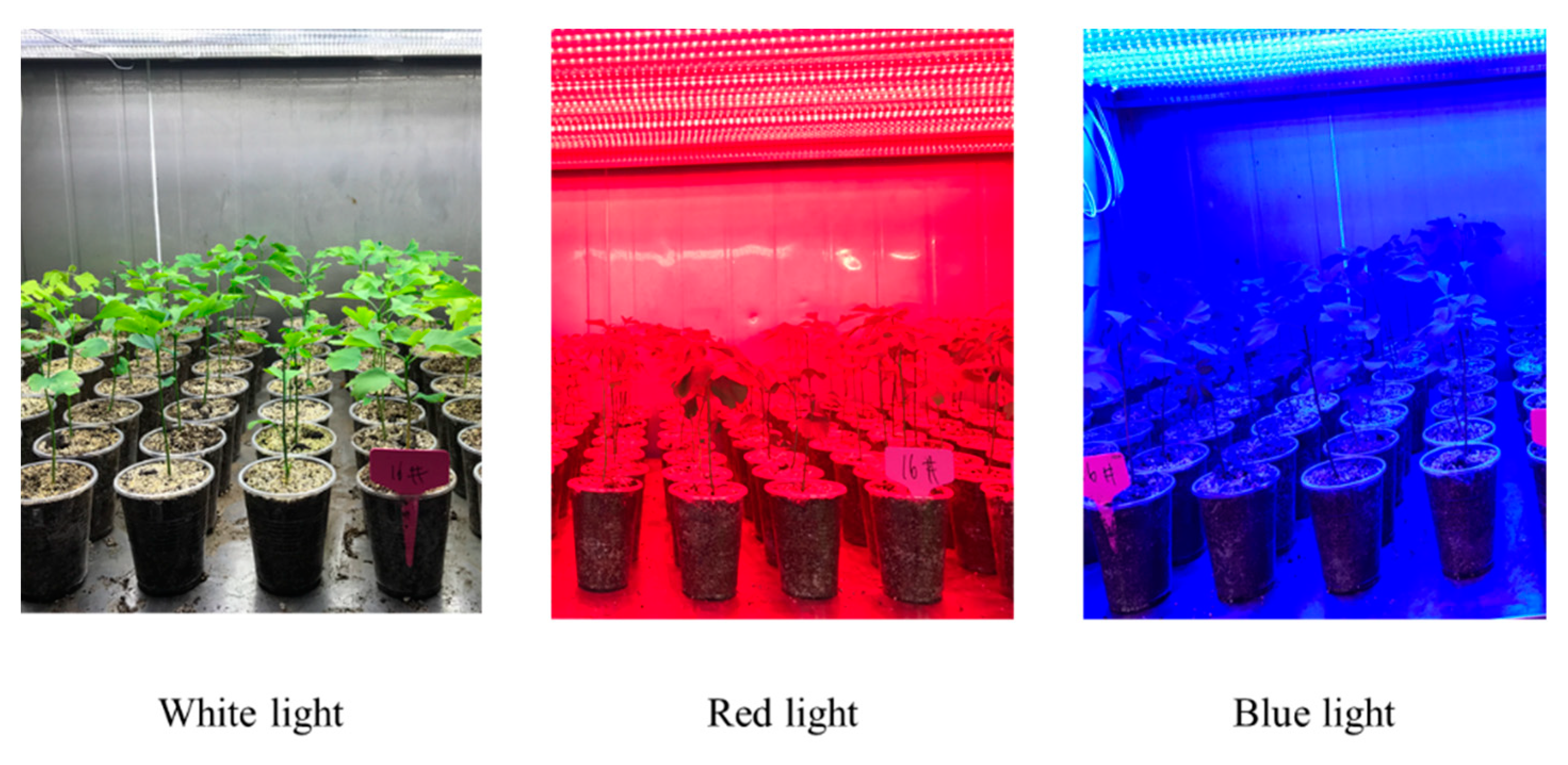
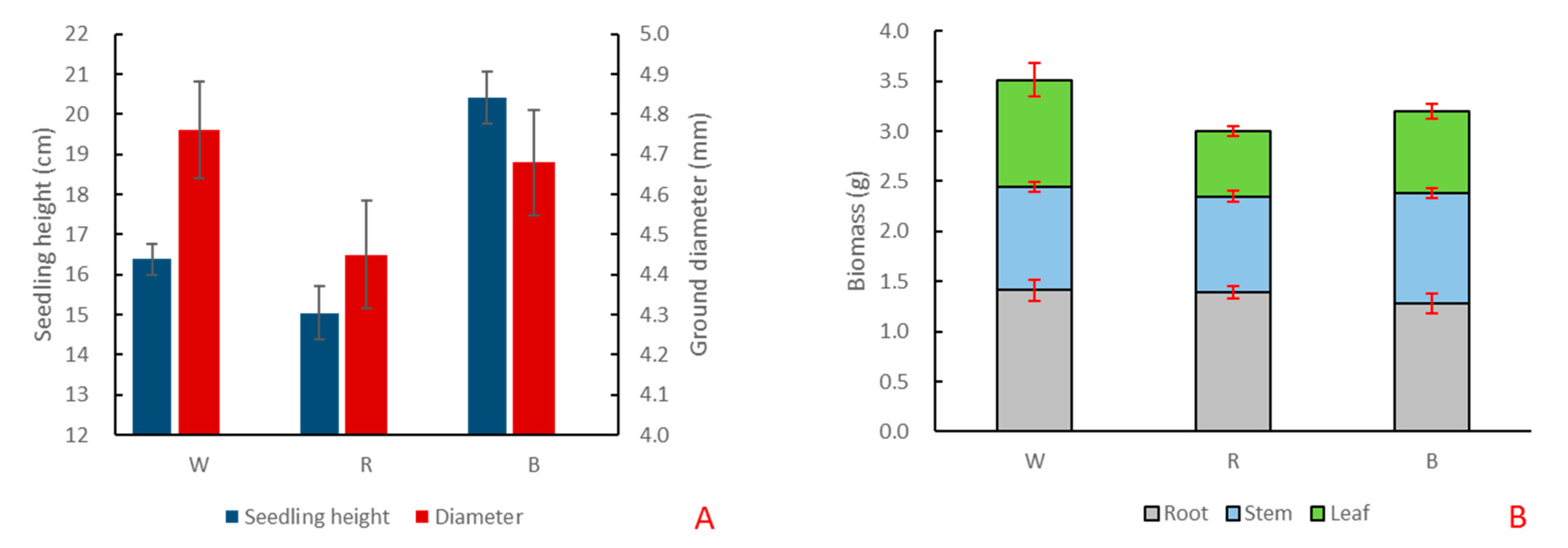
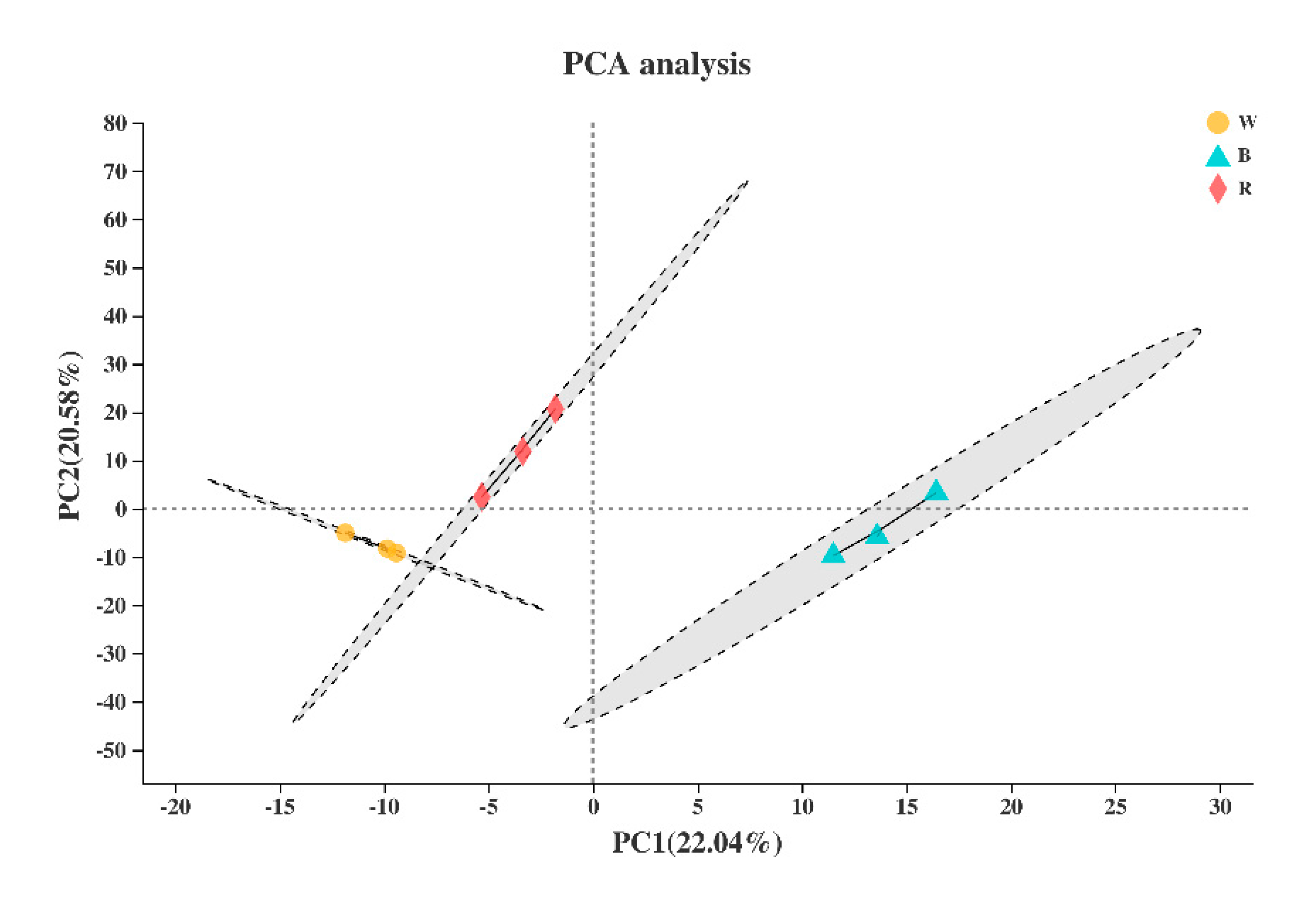
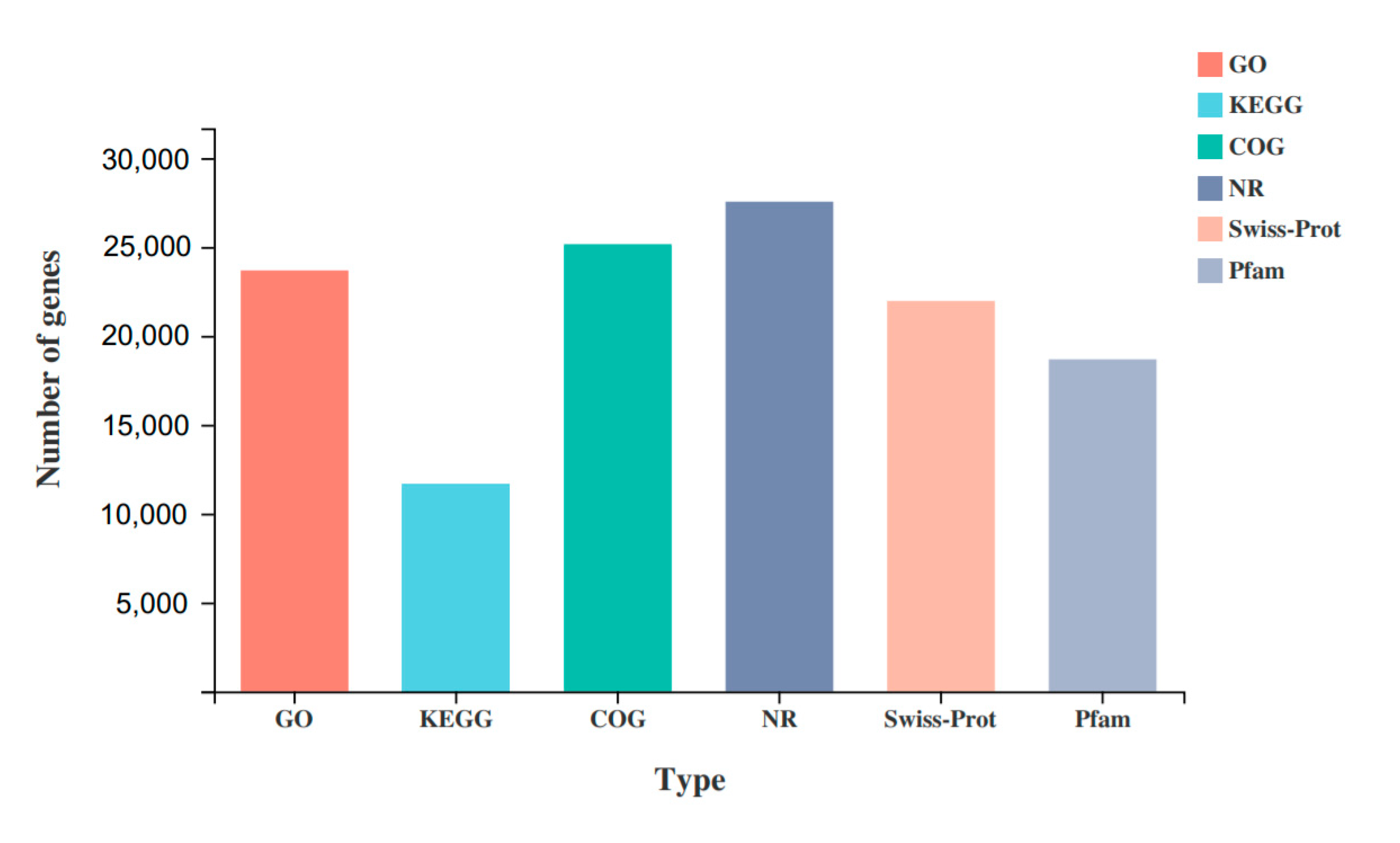

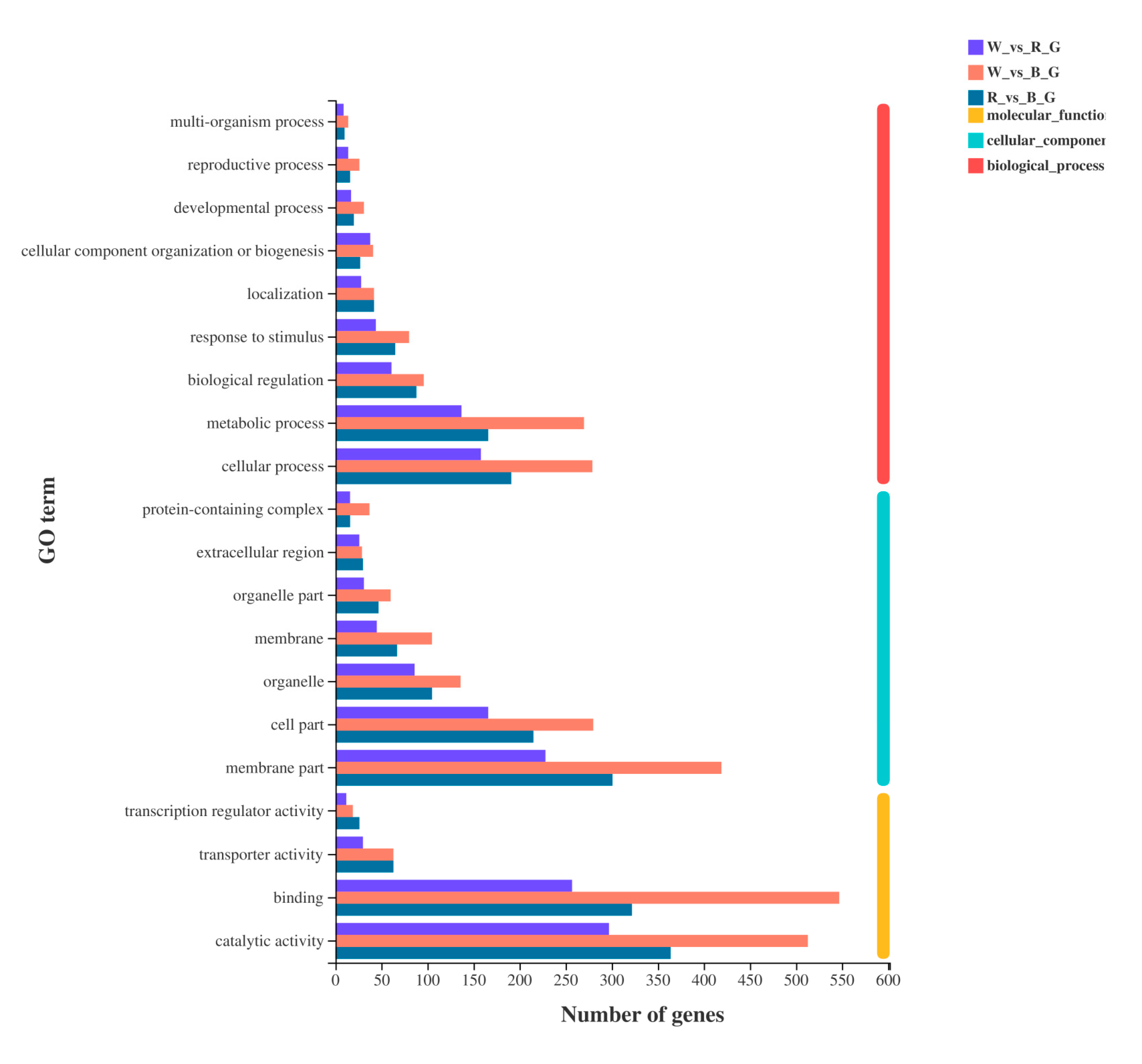



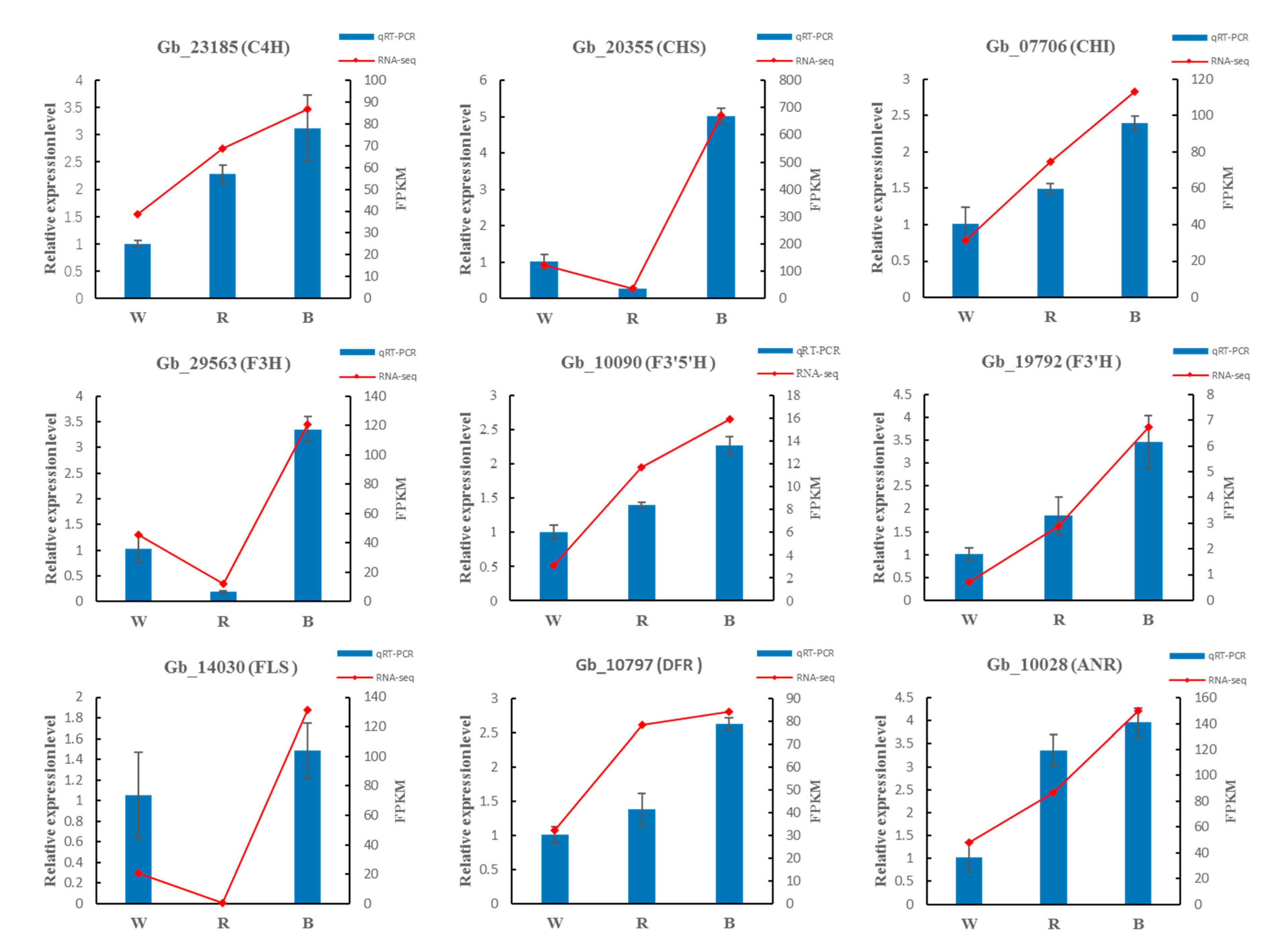
| Gene ID | Forward Primer (5′–3′) | Reverse Primer (3′–5′) |
|---|---|---|
| GAPDH | ATCCACGGGAGTATTCAC | CTCATTCACGCCAACAAC |
| Gb_23185 | CCTGGCCCATTCGCATT | AACCGAACTCCACACCTT |
| Gb_20355 | AAAAGTCCAAAGAAGCGGCAT | AACCAGGCCCAAACCCAA |
| Gb_07706 | AGCAAGGTAGCCATTCCA | AGCCATTGACAAATATGAGGA |
| Gb_29563 | CAGACCCCGGCACCATC | CTCCTTCTCCTCTATGTGCTT |
| Gb_10090 | GCTTCTCCCACAGGTCCG | CACAACCCAGAGATAGCCA |
| Gb_19792 | CCCTGCAAATCCATCCAC | ATTGCACAACATCAACGTC |
| Gb_14030 | CGCCCTCAAACCATACCTT | CTGCTTGCCAACCGTCT |
| Gb_10797 | TGCCCTCTCCCTCATCACC | CATAAACCCAAGATACCCGAT |
| Gb_10028 | GCTTATCCTACTGCCGGTCA | TTCGCACAACTCCGCTCT |
| Sample | Raw Reads | Clean Reads | Total Mapped | Multiple Mapped | Uniquely Mapped | Q30 (%) | GC Content (%) |
|---|---|---|---|---|---|---|---|
| W1 | 50,260,172 | 49,857,286 | 47,146,280 (94.56%) | 4,020,380 (8.06%) | 43,125,900 (86.5%) | 95.48 | 47.29 |
| W2 | 49,152,842 | 48,745,716 | 45,997,218 (94.36%) | 3,420,423 (7.02%) | 42,576,795 (87.34%) | 95.16 | 46.65 |
| W3 | 54,486,246 | 54,039,390 | 51,176,322 (94.7%) | 4,387,848 (8.12%) | 46,788,474 (86.58%) | 95.09 | 47.2 |
| R1 | 51,370,906 | 50,981,158 | 48,424,745 (94.99%) | 3,615,814 (7.09%) | 44,808,931 (87.89%) | 95.29 | 46.76 |
| R2 | 44,458,876 | 43,839,486 | 40,955,359 (93.42%) | 2,795,455 (6.38%) | 38,159,904 (87.04%) | 93.19 | 46.02 |
| R3 | 50,901,456 | 50,503,512 | 47,500,571 (94.05%) | 3,419,144 (6.77%) | 44,081,427 (87.28%) | 94.99 | 46.43 |
| B1 | 50,958,110 | 50,583,964 | 48,020,218 (94.93%) | 2,888,507 (5.71%) | 45,131,711 (89.22%) | 95.28 | 46.55 |
| B2 | 44,497,382 | 44,157,342 | 41,615,152 (94.24%) | 2,775,224 (6.28%) | 38,839,928 (87.96%) | 95.19 | 46.16 |
| B3 | 49,391,368 | 48,979,760 | 46,078,100 (94.08%) | 3,361,108 (6.86%) | 42,716,992 (87.21%) | 95.02 | 46.82 |
Publisher’s Note: MDPI stays neutral with regard to jurisdictional claims in published maps and institutional affiliations. |
© 2021 by the authors. Licensee MDPI, Basel, Switzerland. This article is an open access article distributed under the terms and conditions of the Creative Commons Attribution (CC BY) license (https://creativecommons.org/licenses/by/4.0/).
Share and Cite
Zhang, L.; Wang, G.; Wang, G.; Cao, F. Ginkgo biloba L. Responds to Red and Blue Light: Via Phenylpropanoid and Flavonoid Biosynthesis Pathway. Forests 2021, 12, 1079. https://doi.org/10.3390/f12081079
Zhang L, Wang G, Wang G, Cao F. Ginkgo biloba L. Responds to Red and Blue Light: Via Phenylpropanoid and Flavonoid Biosynthesis Pathway. Forests. 2021; 12(8):1079. https://doi.org/10.3390/f12081079
Chicago/Turabian StyleZhang, Lei, Gaiping Wang, Guibin Wang, and Fuliang Cao. 2021. "Ginkgo biloba L. Responds to Red and Blue Light: Via Phenylpropanoid and Flavonoid Biosynthesis Pathway" Forests 12, no. 8: 1079. https://doi.org/10.3390/f12081079





